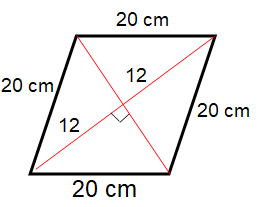PROBLEMS ON DIAGONALS OF 2D SHAPES
Subscribe to our ▶️ YouTube channel 🔴 for the latest videos, updates, and tips.
Problem 1 :
If the diagonal of a rectangle is 17 cm long and its perimeter is 46 cm, find the area of the rectangle.
Solution :
Let Length = x and width = y
Length of the diagonal = 17 cm
x2 + y2 = 172
x2 + y2 = 289 ----(1)
Perimeter of the rectangle = 46 cm
2(x + y) = 46
Dividing by 2, we get
x + y = 23
Using the algebraic identity
a2 + b2 = (a + b)2 - 2ab
x2 + y2 = (x + y)2 - 2xy
Applying x2 + y2 in (1), we get
x2 + y2 = 289
(x + y)2 - 2xy = 289
232 - 2xy = 289
529 - 289 = 2xy
240 = 2xy
xy = 120
So, area of the rectangle is 120 cm2.
Problem 2 :
One side of the rectangular field is 15 m and one of its diagonal is 17 m. Find the area of the field.
Solution :
Length and width be the dimensions of the rectangle.
(Length)2 + (width)2 = (diagonal)2
Let length = 15 m
(15)2 + (width)2 = 172
225 + (width)2 = 289
(width)2 = 289 - 225
Width = √64
width = 8 m
Area of the rectangle = 15(8)
= 120 m2
Problem 3 :
Find the area of square, one of whose diagonals is 3.8 m long.
Solution :
Since it is square, length of all sides will be equal.
a2 + a2 = (3.8)2
2a2 = 14.44
a2 = 7.22
So, area of the square is 7.22 m2
Problem 4 :
Find the area of a rhombus one side of which measures 20 cm and one diagonal 24 cm.
Solution :
In rhombus, the diagonals will bisect each other at right angle

Let 2x be the length of the another diagonal. So, x be its half length.
122 + x2 = 202
144 + x2 = 400
x2 = 400 - 144
x2 = 256
x = √256
x = 16 cm
Area of rhombus = (1/2) ⋅ 32 ⋅ 24
= 384 cm2
Problem 5 :
One diagonal of a parallelogram is 70 cm and the perpendicular distance of this diagonal from either of the outlying vertices is 27 cm. The area of the parallelogram is.
Solution :
The diagonal will divide the parallelogram into two triangles of equal area.
Base of the triangle = 70 cm
height of the triangle = 27 cm
Area of one triangle = (1/2) ⋅ 70 ⋅ 27
= 945 cm2
Area of parallelogram = 2(945)
= 1800 cm2
Subscribe to our ▶️ YouTube channel 🔴 for the latest videos, updates, and tips.
Recent Articles
-
Finding Range of Values Inequality Problems
May 21, 24 08:51 PM
Finding Range of Values Inequality Problems -
Solving Two Step Inequality Word Problems
May 21, 24 08:51 AM
Solving Two Step Inequality Word Problems -
Exponential Function Context and Data Modeling
May 20, 24 10:45 PM
Exponential Function Context and Data Modeling